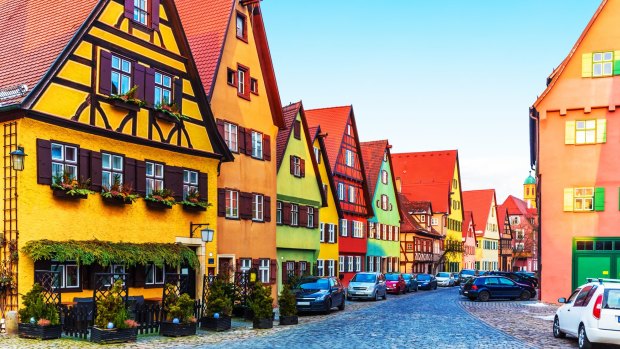This was published 5 years ago
Germany: Dinkelsbuhl is a town where you get both medieval charm and a glimpse of ordinary life

Dinkelsbühl shows off its medieval charms and colourful character.
In this tale of old-town twins, Rothenburg-ob-der-Tauber was adopted by rich Americans and lived happily ever after as a medieval la-la land of plum tarts, petunias and postcards. Dinkelsbühl appeared to draw the short straw. It was sent into stout German obscurity and made do with boiled sausages and manufacturing spare parts for cars.
The two old towns are 50 kilometres apart and have much in common, however. Both were free imperial towns with important rights and tax privileges, sitting on the north-south crossroads of central Europe. Both saw the emergence of the burgher class and became wealthy. Both collapsed economically after the Thirty Years War and sat for 300 years in a well-preserved time warp of churches, half-timbered houses and battlements.
Dinkelsbühl, however, is more authentic. Much of it is the real old deal, while a good third of Rothenburg was bombed in World War II and reconstructed. Five thousand people live within Dinkelsbühl's fortifications. Shops sell toothbrushes and tomatoes. You can eat roast carp or Swabian braised beef in a restaurant full of German speakers.
Not that you should avoid Rothenburg, which is beguiling. The old towns are on the delightful Romantic Road tourist route in south-west Germany, so it's easy to visit both and plenty more. But don't overlook Dinkelsbühl. It's less glamorous, more charming and homey. You get a beautiful old town, but experience everyday Germany too.
Start in the museum, whose unassuming entrance is tucked inside the tourist office. As small-town museums go, it's modern and interesting, and succinctly explains Dinkelsbühl's history and its wider context. A time-lapse video showing the 800-year construction and redesigns of St George's Church is fascinating. Nearby is a dragon drainpipe with extraordinary eyelashes, rescued from the church roof.
The Middle Ages was a decorative time of statue-studded fountains, gargoyles and carved doors, and Dinkelsbühl leaves it that way. You'll see no advertising or neon signs, and the facades of the houses are colour controlled, though still a chirpy combination of orange, daffodil and red.The first parts of the town walls date from the 10th century. You can't walk on them but (unusually) you can walk all around them, as open space has been preserved around the entire circumference. Along the way you pass 18 towers and four gateways, plus a pretty swan-paddled pond that once supplied the town with its carp.
Inside the walls is an almost perfectly preserved medieval and Renaissance old town that never progressed beyond the 1630s and so almost entirely avoided baroque and other remodelling. Dinkelsbühl was no obscurity but a significant trade city that grew wealthy on woollen cloth and other goods. Its merchants built big gabled houses, huge storerooms, a hospital and debtors' prison, and several churches.
The main church (St George) is one of Bavaria's finest late-Gothic masterpieces with impressive fan vaulting and ornate altars. You can climb its tower for a pleasing view, or join a free evening nightwatchman tour that leaves from its steps and progresses around the old town.
Almost across the road, cravings of the flesh are taken care of at Deutsche Haus, a hotel and restaurant since it was built in the 16th century. A statue of Bacchus prances on its façade, along with other classical gods and some wandering planets. It's surely one of Germany's prettiest buildings, and part of a pretty ensemble that forms Weinmarkt (Wine Market) square.
The Wochenmarkt still hosts the farmers' market, where cabbages and potatoes tumble. That's what's really nice about Dinkelsbühl. Local kids loiter outside the bakeries, clothes flutter from lines and retirees potter in the gardens of this lucky twin town.
TRIP NOTES
Brian Johnston travelled as a guest of the German National Tourist Office, Romantic Road and Dinkelsbühl Tourist Service.
MORE
FLY
Etihad flies to Abu Dhabi and Frankfurt, which is a two-hour drive from Dinkelsbühl. See etihad.com
STAY
Renovated Dinkelsbühl Youth Hostel inhabits a vast medieval corn storehouse and has sports facilities, barbecue area and gardens. See dinkelsbuehl.jugendherberge.de
Sign up for the Traveller Deals newsletter
Get exclusive travel deals delivered straight to your inbox. Sign up now.